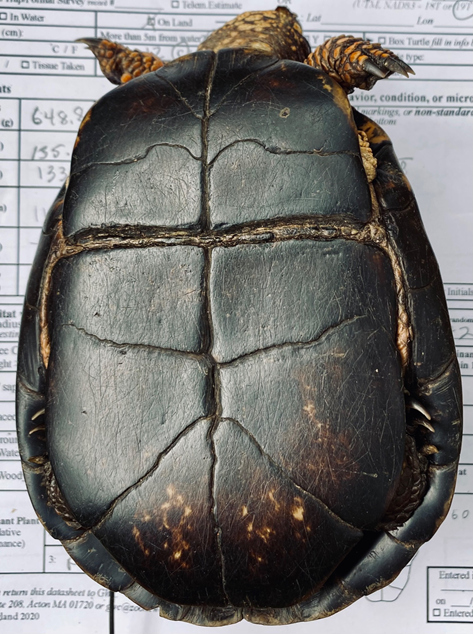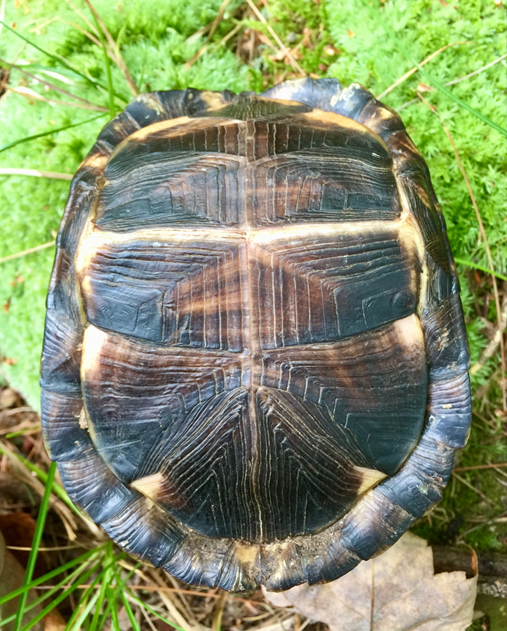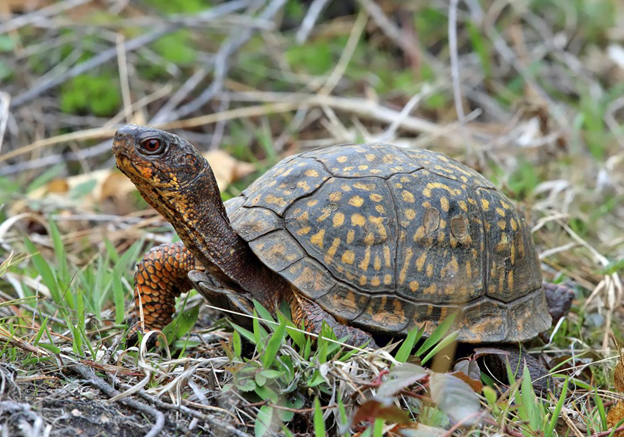This week, we’re zooming in on one of the animals we’ve spent so much time in the field following and learning from. We often say that the animals are our best ambassadors for conservation, and as we study them, we being to learn their individual quirks. Our veteran field biologist, Julie Lisk, shares some observations about her favorite eastern box turtle, Speckles.
As the days grow longer and warmer, I eagerly await the emergence of Speckles. With her defiant attitude, regal posture, and wisdom of the forest, I consider her to be the Queen of the Forest. I first encountered her in May 2017, after 3-weeks of intense searches for eastern box turtles.

She had probably recently emerged from hibernation and was nestled amongst a patch of still leafless shrubs located in bright sun; She was barely visible amongst the dried leaves and shrub stems. Had I not been purposely looking for box turtles I likely would have passed by her without notice, and probably did so several times! So as to learn more about her we attached a radiotransmitter to her shell. She proved to be a key surveyor to our team, as her movements guided us to new individuals, and thus helped us demonstrate a viable population.
As her name suggests, she has numerous small butter-yellow specks on the top of her head. Look for them in the video. We don’t know her precise age, but based on her worn and smooth carapace and absence of annuli, we estimate her to be at least 50 years of age, possibly older. Some turtles, when younger, can be aged based on the number of annuli on their plastron, in much the same way trees are aged. After approximately 20 years of age, the annuli begin to wear away and each year thereafter it becomes more difficult to age them accurately.


Marks on her carapace show the scars of past battles; On either side of it are the healed wounds of an animal bite that likely clasped her in its jaw and bit down hard on her shell, possibly a black bear. We have seen similar wounds on other box turtles. Fortunately, her tough shell and her ability to completely retract her head and limbs into her shell and “box up” provides her extra protection. However, the shell has its limits and is no match for a car – a worrisome danger for all turtles, especially females, who often wander far in search of nest sites.

Speckles is generally the earliest to nest, along with Ms. Birdie, usually by May 31. Always full of surprises, one year Speckles laid a second clutch, the first documented record in Massachusetts.
One summer day when I was radiotracking Speckles, I came upon only her transmitter. The transmitter had bite marks on it, and the antenna was badly mangled. I went into panic mode. After, I calmed myself down I went on a search for her. I searched in all her favorite nooks and crannies, and to my great surprise and relief I located her. She had no observable injuries, but she gave me a good scare!
On multiple occasions we have come upon Speckles eating. She relishes the Russula species of mushroom in late summer and fall. By many accounts one of her favorite foods may be slugs, as indicated by the number of times we have seen the remains of them on her face. To my amazement, I even once watched her catch and eat a flying insect! There’s a rumor out there that she especially likes cantaloupe.
As the days become shorter and temperatures decline in autumn, Speckles readies for a long hibernation. By mid-October she settles into a depression in the forest where leaf litter is thicker, thus providing more insulation than a flat surface. She digs below the leaf and duff layers, about 3-4 inches, and then a bit further down until her plastron is in contact with the soil. As temperatures continue to decrease she will dig further down into the soil to avoid freezing. Complete spring emergence is slow. During warm days of late winter and spring she may emerge to bask, and return to her hibernaculum by night. By late April to early May when the risk of freezing has passed, Speckles will seek out the sun at the forest edge.
As we approach our sixth year of following Speckles, what other surprises might she reveal? This remains to be seen, and spring can’t come soon enough!

Anne Gagnon
Great job, Julie!
I am sure lots of folks will find your article fascinating.
Bill
Where does she live ? In the wild ? Are there box turtles in Franklin Park ?
Matt Kamm
She does live in the wild! We also have “ambassador animal” box turtles who are not releasable, and they do live at Franklin Park Zoo.
Mike Z
Love the work you do. No one else is doing it in our area. Keep up the good work.